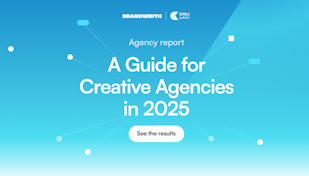The Designer of the future

For graphics professionals nowadays the actual creation of original artwork and documents only accounts for a small portion of their work. A significant amount of time, sadly, is spent on mundane and repetitive tasks like creating variations of existing artworks. The designer of the future will leverage the power of smart templates to be able to focus more on the creative aspect.
Graphic design has been in full transformation since time began.
Humans have expressed themselves with graphics since the dawn of time, from the earliest drawings made with charred remnants of spent firewood in cave dwellings to today's digital media channels. The next thing to completely transform graphics has always been just around the corner, hot on the heels of technology about to become obsolete. Talk to anyone who has been in graphics for more than a few years, and they will speak with nostalgia of the now-extinct technology they used to love.
More graphics are needed as time goes on.
Over the last few years, the changes have been nothing short of monumental. The digital revolution has blurred the lines between channels and requires many more graphics of many more different types than ever before.
Branding was traditionally limited to more static things, like marketing materials, stationery, and signage. Today's companies have realized that great design is good for business, and are keen to offer more immersive brand experiences. As they begin branding everything in sight, they quickly realize the number of visuals required for extensive omnichannel branding is gigantic. Digital branded assets like online ads, for example, often have a limited life span and constantly need to be updated or rebuilt.
Also, the field of activity of a typical designer is likely to extend beyond the physical and online: brands are likely to want to personalize graphics, driven by marketing automation platforms and variable data printing. They may well want to go much further and brand 3D printed objects or use augmented reality to brand the way consumers experience their environment. As companies extend the reach of their brand, the need for visual content will increase, and designers will be expected to build more graphics than ever, for more applications than ever. Graphic design skills will become an important asset soon.
The Designer of the future
Graphic design may be undergoing its next transformation, and designers see their work experienced in many different contexts. So, what does the designer of the future look like?
Curating vs creating
Graphic design has its spectrum: on the one extreme users cannot edit graphics at all; they are created by the designer and the designer only. Any changes, however small, need to be requested from the designer, who then creates and delivers a new static file. This approach, while providing brand governance, is expensive and will not scale: the only way to increase bandwidth is to add more human capital. On the other end of the spectrum, end users get access to native files and all the tools to do the edits, and they build their graphics with no real brand governance to speak of. Chaos usually ensues.
Consumers go on a journey with a brand, on many channels at once. Campaigns span a network of interdependent technologies, platforms, and communities that extend far beyond print (web sites, LinkedIn, Facebook, Instagram to name but a few). Any change in the graphics built for one of these channels immediately affects all others. Traditional approaches to graphics are not well-suited to handle these challenges. There is a high risk of fragmentation and loss of brand consistency across channels. Designers must navigate complexity and remain focused on two things: brand consistency and user experience.
The sweet spot lies somewhere between total freedom and absolute restriction: a controlled approach with smart templates, where the designer chooses which elements of the brand identity are fixed and non-negotiable, and which elements an end-user is allowed to edit and how. The designer thinks of several what-if scenarios and sets up how other elements will react automatically to an end user's edits.
Designers of the future become curators and caretakers for a collection of smart templates, and let end users self-service and modify graphics. Smart templates keep the brand well-defined and consistent at every touchpoint on the customer journey, regardless of whether these are physical or digital.
Less execution
Forrester has found that 70% of customers prefer to self-service online when engaging with companies, rather than use phone or email. This means users are likely to want to autonomously build the graphics they need — with some assistance from the smart template — rather than to request for edits to be done for them.
Traditional design skills and knowledge are no longer the only things required. Designers of the future will act more like product managers for smart templates: they will build fewer graphic files, but the smart templates they do create will contain systems and strategies to make end-users self-reliant.
This means designers of the future stop fulfilling requests for individuals or departments, and begin working for the brand.
Work at scale
Designers of the future can have a much greater impact as users become self-reliant. Instead of scheduling their work around other people's deadlines, designers of the future can build and administer many smart templates. End users can create the graphics they need, without any assistance. This makes the available bandwidth for visual communication no longer limited to the hours in a day but driven by the number of people they give access to smart templates.
Different compensation
It is becoming increasingly difficult to earn a decent wage for traditional designers. Employers are looking at low-cost freelance platforms like Fiverr and similar web sites, with their low quality and stolen-but-reworked designs, and using the prices there as a benchmark.
Making the shift from a paid-by-the-hour execution role to a more strategic one has implications on how designers of the future are compensated for their work. This may seem challenging at first, but we need to keep in mind that the traditional upper limit to compensation is limited by the number of billable hours in a day; smart designers work at scale and let end users self-service.
Instead of paying for a designer's time, companies will need to pay for ideas, templates, and completed projects. Some brands have already seen the future and are changing the way they compensate designers in these new, changed roles. They are already aware of the cost of good design at scale.
If you think good design is expensive, you should look at the cost of bad design
Dr. Ralf Speth
Jaguar
Transforming jobs
Most graphic design jobs followed a traditional career path: designers would work in larger organizations, and stay in jobs for longer. The next generation of designers, however, want more freedom and flexibility and don't want to rely on a single employer. They are already turning to freelance work, using online platforms to connect to potential employers.
Remote work has become more mainstream, specifically for roles that require focused attention and minimal distractions. Companies worldwide are seeing the advantage of — instead of tying employees to their desk — letting them work from wherever they like.
The designers of the future may freelance, and won't necessarily work in the office.
Visual communication becomes a strategic role.
Designers of the future are experts in a very specific niche: how to provide brand governance and protect a design under varying circumstances; they will act as caretakers of a visual style or a brand
The role of the designer is set to become more strategic, and less focused on execution and external deadlines, and they need to prepare for these changes. This change will have implications on what designers deliver and how they get compensated for it.
Designers of the future will think digital-first, work at scale, and democratize visual communication by simplifying and automating parts of the graphic design process to allow people with no graphics expertise to edit smart templates while protecting brand identity guidelines.
The designers of the future make everyone a designer.
What are SMART TEMPLATES?
Smart Templates are a type of documents set up to help people with no graphics knowledge to build and edit documents by embedding design decisions or brand identity guidelines in them. They are used to build all kinds of graphics for print and online.
What is the ALTERNATIVE to smart templates?
The traditional way to produce graphics. This involves a designer building the graphics document and all variants and iterations of it. It is generally too slow and expensive to scale.
Marketing
Piet Saegeman
Oct 18, 2019
Sign up for blog updates
Related articles
Product,
Company
Nico Potvin
Mar 5, 2019


